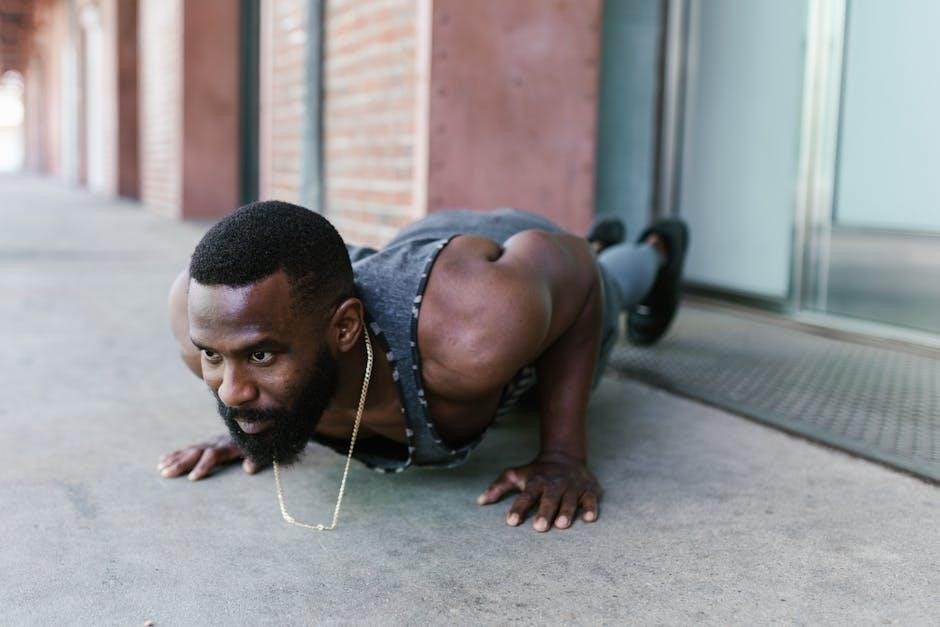
A 30-minute bodyweight workout offers a convenient, effective way to build strength, burn calories, and improve flexibility without equipment. Perfect for all fitness levels, it combines dynamic movements, isometric holds, and HIIT elements for a full-body challenge. Ideal for busy schedules, these workouts can be done anywhere, making them a versatile option for maintaining physical and mental health. This guide provides structured routines, exercise tutorials, and progression tips to help you maximize your 30-minute sessions and achieve your fitness goals efficiently.
Overview of Bodyweight Training
Bodyweight training uses your own weight as resistance to build strength, endurance, and flexibility. It’s versatile, requiring no equipment, and can be done anywhere. Exercises like push-ups, squats, and planks engage multiple muscle groups, making it a holistic approach to fitness. Suitable for all fitness levels, bodyweight workouts can be modified to challenge beginners or advanced individuals, promoting overall physical development and functional movement;
Why 30 Minutes is an Effective Duration
A 30-minute workout strikes a balance between efficiency and effectiveness, allowing for a full-body challenge without excessive time commitment. It combines strength training and cardio elements to maximize calorie burn and mental health benefits. This duration is ideal for busy schedules, enabling consistent progress while accommodating progressive overload to keep workouts engaging and challenging over time.
Benefits of a 30-Minute Bodyweight Workout
Calorie Burning and Weight Loss: Efficiently burns calories during and after exercise. Muscle Strength and Endurance: Builds lean muscle and improves overall physical resilience. Improved Mental Health: Reduces stress, boosts mood, and enhances focus. A time-efficient, equipment-free solution for a healthier lifestyle.
Calorie Burning and Weight Loss
A 30-minute bodyweight workout is an excellent way to burn calories and support weight loss. High-intensity exercises like burpees, jump squats, and mountain climbers elevate heart rate, maximizing calorie burn during and after exercise. Consistent sessions enhance metabolism, helping shed pounds while toning muscles. This efficient approach makes it ideal for those with busy schedules aiming to maintain a healthy weight.
Muscle Strength and Endurance
Bodyweight exercises in a 30-minute workout effectively build muscle strength and endurance by engaging multiple muscle groups. Squats, push-ups, and lunges target major muscles, promoting lean muscle growth and improving overall muscular stamina. Consistent practice enhances your ability to perform daily activities with more energy and endurance, while progressive overload ensures continued strength gains over time.
Improved Mental Health
A 30-minute bodyweight workout significantly enhances mental well-being by reducing stress and anxiety. The release of endorphins during exercise boosts mood and energy levels, while the accomplishment of completing a session fosters a sense of achievement and confidence. Regular practice also improves focus and reduces symptoms of depression, promoting overall mental clarity and emotional balance.
Structure of a 30-Minute Bodyweight Session
A 30-minute bodyweight session typically includes a 5-10 minute dynamic warm-up, followed by 20-25 minutes of targeted exercises or circuits, and ends with a 5-10 minute cool-down with stretching.
Warm-Up Routine
A dynamic warm-up prepares the body for exercise, enhancing flexibility and circulation. Start with 5-10 minutes of high knees, butt kickers, arm circles, and jumping jacks. Incorporate leg swings, torso twists, and inchworms to activate major muscle groups. Conclude with gentle walk-outs or plank holds to engage the core and prevent injury, ensuring a smooth transition into the workout.
Main Workout Exercises
The main workout includes a circuit of bodyweight exercises targeting strength and endurance. Perform squats, push-ups, lunges, and planks to engage the full body. Incorporate dynamic movements like burpees and jump squats for intensity. Aim for 3-4 rounds of 10-15 reps per exercise, resting briefly between sets to maintain form and maximize efficiency within the 30-minute timeframe.
Cool-Down and Stretching
Finish your workout with a 5-minute cool-down to promote recovery and flexibility. Static stretches like hamstring, chest, and quad stretches help relax muscles. Gentle movements, such as leg swings and arm circles, improve circulation. Deep breathing exercises can reduce stress and transition your body back to a resting state after intense activity.

Effective Exercises for a Full-Body Workout
Combine upper, lower, and core exercises for a balanced workout. Push-ups, squats, planks, and lunges target multiple muscle groups, enhancing strength, endurance, and coordination without equipment.
Upper Body Exercises
Push-ups, pike push-ups, and planks target the chest, shoulders, and triceps. Incline push-ups and tricep dips work the upper body effectively. For advanced levels, try single-arm push-ups or dynamic variations to increase intensity and challenge muscles further, ensuring a strong and balanced upper body workout in just 30 minutes.
Lower Body Exercises
Squats, lunges, and glute bridges strengthen the legs and glutes. Bodyweight exercises like calf raises and side lunges also target the lower body. For added intensity, incorporate step-ups or single-leg squats. These movements improve balance, endurance, and overall lower body strength, making them essential for a comprehensive 30-minute workout routine.
Core and Functional Movements
Planks, hollow rocks, and supermans target the core, improving stability and posture. Functional movements like bird dogs and bear crawls enhance coordination and overall athleticism. These exercises engage multiple muscle groups, promoting a strong, balanced physique. Incorporating them into your 30-minute routine ensures a well-rounded workout that boosts both core strength and functional fitness effectively;

Sample 30-Minute Workout Routine
Start with a dynamic warm-up, then perform a circuit of squats, push-ups, and lunges. Aim for 3-5 rounds, resting minimally between exercises. Finish with a cool-down and stretching.
Round-Based Circuit Training
A round-based circuit involves completing exercises like squats, push-ups, and lunges in succession. Perform 3-5 rounds, each lasting 5-7 minutes, with 30-60 seconds rest between each round. Ideal for all fitness levels, this format boosts strength and endurance while keeping the workout dynamic and engaging. Focus on form to ensure safety and effectiveness.
HIIT (High-Intensity Interval Training) Options
HIIT involves short bursts of intense exercise (20-30 seconds) followed by brief rest periods (15-30 seconds). Exercises like burpees, jump squats, and mountain climbers are ideal. Repeat for 15-20 minutes, aiming for 3-5 cycles. This format boosts cardiovascular fitness, burns calories, and enhances metabolism. Perfect for time-efficient, full-body conditioning, HIIT can be adapted to suit all fitness levels with scalable intensity and rest intervals.

Modifications for Different Fitness Levels
Scale exercises by adjusting intensity, repetitions, or rest intervals. Beginners can modify push-ups on knees, while advanced users can add explosive movements or reduce rest time.
Beginner Adjustments
For beginners, modify exercises to reduce intensity, such as knee push-ups instead of traditional push-ups. Reduce the number of repetitions or sets and increase rest intervals. Focus on proper form to build a foundation and prevent injury. Incorporate shorter circuits or break exercises into smaller segments to gradually improve endurance and strength over time.
Advanced Progressions
For advanced individuals, increase workout intensity by adding complex exercises like single-leg squats or plyometric movements such as burpees. Reduce rest intervals between sets and rounds to enhance endurance. Incorporate HIIT elements, such as shorter rest periods and time-based challenges, to push limits. Aim for higher volumes with additional sets or reps while maintaining proper form for maximum effectiveness and safety.
Incorporating HIIT for Intensity
HIIT boosts workout intensity with short bursts of high-energy exercises followed by brief rest periods, enhancing cardiovascular fitness and metabolic burn within the 30-minute timeframe effectively.
Exercise Selection for HIIT
Choose dynamic bodyweight exercises like burpees, jump squats, mountain climbers, and plank jacks. Alternate between 30 seconds of maximum effort and 15-30 seconds of rest. Incorporate variations of push-ups, lunges, and core movements to target all muscle groups. This structure maximizes calorie burn, improves cardiovascular fitness, and enhances muscular endurance within the 30-minute timeframe, suitable for all fitness levels and requiring no equipment.
Timing and Rest Intervals
Structure your HIIT workout with 30 seconds of intense exercise followed by 15-30 seconds of rest. Repeat for 15-20 minutes total, completing 3-4 rounds of the circuit. Adjust intervals based on fitness level, ensuring a balance between effort and recovery; This timing optimizes calorie burn and cardiovascular benefits within the 30-minute session, maintaining intensity and focus throughout.
Ensuring Safety and Recovery
Start with a dynamic warm-up, maintain proper form to prevent injuries, and allow adequate rest between exercises. Hydrate and refuel with balanced nutrition post-workout for optimal recovery and muscle repair.
Proper Form and Technique
Maintaining proper form ensures safety and maximizes results. Focus on controlled movements, engage your core, and avoid sacrificing form for speed or repetitions. For exercises like push-ups and squats, keep your body in a straight line and lower slowly. Adjust movements to suit your fitness level, and rest when needed to prevent injury. Prioritize quality over quantity for effective and injury-free workouts.
Post-Workout Recovery Tips
After your 30-minute workout, prioritize recovery to repair muscles and enhance results. Begin with a 5-10 minute cool-down, including stretching to improve flexibility and reduce soreness. Rehydrate with water or electrolytes, and refuel with a balanced meal or protein-rich snack within 30-60 minutes. Ensure 7-9 hours of sleep and consider light activities like walking or yoga for active recovery. This routine supports muscle repair and prepares your body for future sessions.
Progression and Scaling Over Time
Gradually increase workout intensity by adding repetitions, reducing rest periods, or introducing advanced variations like single-leg squats or plyometric movements to challenge your body further.
Increasing Difficulty
To progress, increase repetitions, reduce rest periods, or modify exercises to more challenging versions, such as turning squats into jump squats or push-ups into single-leg push-ups. Incorporating plyometric movements or advanced variations like single-leg deadlifts can further enhance intensity and target muscles more effectively, ensuring continuous improvement in strength and endurance over time.
Tracking Progress
Monitor your progress by logging completed workouts, noting increases in repetitions, sets, or reductions in rest time. Track weight loss, improved form, or enhanced endurance. Use progress photos, measurements, or fitness apps to visualize improvements. Regular tracking helps maintain motivation and ensures consistent growth in strength and overall fitness over time.
Staying Motivated and Consistent
Stay motivated by celebrating small achievements and maintaining a consistent routine. Embrace the convenience of 30-minute workouts and remind yourself of the mental and physical benefits they provide daily.
Setting Goals
Define clear, achievable goals to stay motivated, such as completing a certain number of workouts per week or mastering specific exercises. Track your progress using a PDF guide to monitor improvements and stay accountable. Celebrate small victories to maintain consistency and ensure long-term success in your fitness journey.
Creating a Workout Schedule
Plan your workouts with a structured schedule, allocating specific days for strength, cardio, and mobility. Use a downloadable PDF guide to organize your routine, ensuring consistency and balance. Set reminders and track progress to maintain discipline and achieve your fitness objectives effectively within the 30-minute daily timeframe.
Downloading a 30-Minute Bodyweight Workout PDF
Access a comprehensive guide with structured routines, exercise tutorials, and tracking tools. Ideal for all fitness levels, this PDF offers a convenient, portable workout plan for home or travel.
Features of a Good Workout Guide
A good workout guide includes clear instructions, structured routines, and visual demonstrations. It offers varied exercises, progression options, and nutrition tips. The guide should cater to all fitness levels, providing modifications for beginners and challenges for advanced users. A well-designed PDF ensures workouts are engaging, effective, and easy to follow, helping users stay motivated and track their progress efficiently.
How to Use the PDF Effectively
Start by setting clear fitness goals and scheduling workouts. Use the PDF to guide your routine, tracking progress and adjusting intensity. Focus on proper form, rest intervals, and hydration. Stay consistent, and review the guide regularly to stay motivated and adapt exercises as needed for continuous improvement and optimal results.
Leave a Reply
You must be logged in to post a comment.